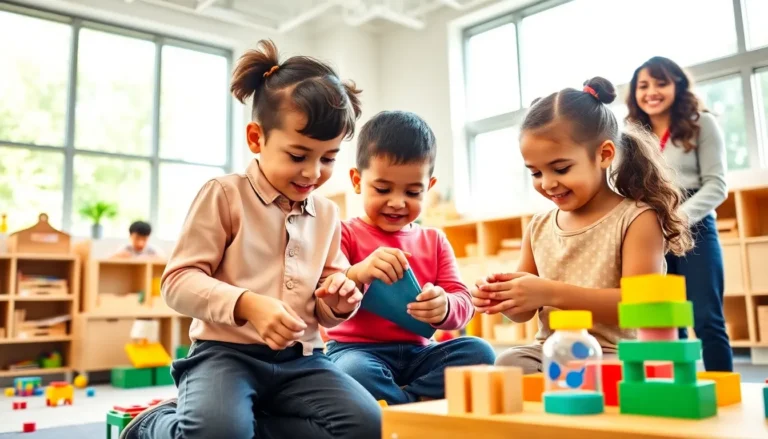Adoption and fostering are like the ultimate superhero team-ups—bringing together loving families and children in need of a place to call home. Imagine being the one who can change a child’s life forever, like giving them their own personal cape to fly into a brighter future. It’s not just about providing shelter; it’s about nurturing dreams, laughter, and maybe even a few awkward family photos that will be cherished for years to come.
In a world where every child deserves a chance, adoption and fostering offer a unique opportunity to make a real difference. Whether it’s a snuggly toddler or a spirited teenager, each child has a story waiting to unfold. So, if you’ve ever thought about opening your heart and home, now might just be the perfect time to join this incredible journey of love and adventure.
Table of Contents
ToggleOverview of Adoption and Fostering
Adoption and fostering provide essential pathways for children to find stable, loving homes. These processes play a crucial role in shaping the lives of vulnerable children. Adoption involves a legal commitment, permanently joining a child to a family, allowing the child to belong and thrive in a nurturing environment. Conversely, fostering serves as a temporary arrangement, offering a safe haven for children until they can reunite with their biological families or transition to adoption.
Each pathway serves distinct purposes. Many foster parents become advocates for children’s rights, helping them heal from past traumas. In contrast, adoptive families celebrate the milestone of permanence, often embracing children from diverse backgrounds and life experiences. Adoption may occur through various channels, including private agencies and public systems, while fostering often connects children with nearby families to minimize disruptions in their lives.
Specific numbers highlight the significance of these movements. According to the Adoption and Foster Care Analysis and Reporting System, over 400,000 children are in foster care in the United States. Approximately 135,000 children are adopted each year. Those statistics underscore the ongoing demand for foster and adoptive families.
Emphasizing community involvement strengthens these supports. Community outreach programs and local organizations play essential roles in educating potential families about the processes involved. They offer resources and training to equip families with the tools needed to nurture children effectively.
Ultimately, both adoption and fostering offer unique opportunities. Individuals committed to making a meaningful difference can shape a child’s life story through these acts of kindness. Cultivating connections between families and children creates lasting impacts, facilitating growth, and building futures filled with hope and love.
Types of Adoption

Adoption encompasses various paths to creating families. Understanding these types helps prospective parents make informed decisions.
Domestic Adoption
Domestic adoption occurs within a specific country. In the U.S., this process involves children from foster care systems, newborns placed for adoption, and private arrangements. Agencies facilitate these adoptions, ensuring legal protection for all parties involved. With about 135,000 adoptions annually, domestic adoption remains a reliable option for those eager to provide loving homes to children in need.
International Adoption
International adoption connects families with children from different countries. Each country has unique requirements, making it essential for potential parents to understand the laws governing these adoptions. Procedures may vary widely, including home studies and travel to complete the adoption process. Families often embrace cultural differences, enriching their household while providing a loving environment. In 2022, over 2,100 children found homes through international adoptions in the U.S.
Foster Care Adoption
Foster care adoption offers a pathway for children currently in the state’s system. These children often face temporary placements, seeking permanence in a new family. Foster care adoption occurs when children cannot return to their biological families, allowing them to find stability. Potential parents navigate the child welfare system, with various resources available. This type of adoption provides opportunities for long-term connections, with about 51,000 children adopted from foster care every year.
The Adoption Process
The adoption process involves several critical steps.
Steps to Adoption
First, prospective parents must choose an adoption type, whether domestic or international. Completing a home study follows, where social workers assess the suitability of the home environment. Training sessions often provide valuable insights into parenting an adopted child. After the home study approval, parents can begin matching with children. Finally, legal proceedings finalize the adoption, granting permanent parental rights.
Legal Considerations
Understanding legal requirements is essential for adoption. Each state has specific adoption laws that must be followed. Background checks, financial assessments, and documentation of health are typical prerequisites. It’s also important to comprehend parental rights, including termination processes. Following regulations safeguards the child’s well-being and helps avoid future legal complications.
Matching Children with Families
Matching children with families requires careful consideration. Agencies assess family dynamics, preferences, and children’s needs during this process. They prioritize ensuring a supportive environment for the child’s growth. Events like adoption fairs help facilitate connections by allowing families to meet children in need of homes. This thoughtful matchmaking builds strong, lasting relationships between families and their new children.
The Fostering Journey
Fostering represents a vital avenue for children in need to find stability. This process involves different types that cater to specific circumstances.
Types of Foster Care
Several categories encompass foster care options. Emergency foster care provides immediate placement for children in crisis situations. Short-term foster care supports children awaiting reunification with their families within a few weeks. Long-term foster care serves children needing stability for extended periods, potentially until they age out of the system. Specialized foster care addresses unique needs of children with disabilities or behavioral challenges. These diverse arrangements ensure a tailored response for each child’s situation.
The Role of Foster Parents
Foster parents play critical roles in children’s lives. They offer a safe, nurturing environment, acting as advocates for children’s rights. Guidance and support help children navigate emotional challenges and adjust to new settings. Parents maintain relationships with biological families, promoting continuity during transitions. Training prepares them to handle various situations, equipping them with resources to care for children effectively. Foster parents significantly impact lives, helping children heal and grow throughout their journey.
Challenges and Rewards
Fostering presents both challenges and rewards. Parents often face emotional strain when children transition in and out of their care. Daily routines may disrupt as families adapt to new children entering their homes. Resources might feel limited when addressing specific needs of foster children. Despite these hurdles, rewards include witnessing children’s progress and success. Satisfaction comes from providing a sense of belonging and love, helping children overcome adversity. The experience transforms lives, imparting valuable lessons for both children and foster families.
Adoption and Fostering Resources
Numerous resources exist to support individuals and families interested in adoption and fostering. Various organizations offer assistance, information, and education.
Support Organizations
National organizations like the Adoption and Foster Care Analysis and Reporting System (AFCARS) provide valuable data and insights. Local agencies also play critical roles by offering personalized guidance tailored to unique situations. Support networks establish connections among foster and adoptive families, creating a sense of community and shared experience. Organizations such as the Dave Thomas Foundation for Adoption focus on raising awareness and providing resources. Additionally, state-specific agencies help navigate the legal processes and requirements.
Educational Materials
Numerous educational materials enhance understanding of the adoption and fostering process. Books, articles, and online resources cover topics like home studies and the emotional aspects of fostering. Workshops often facilitate hands-on training, emphasizing skills needed for effective parenting. Furthermore, webinars address current trends in adoption, including cultural sensitivity and legal requirements. State agencies typically provide materials specific to local laws, ensuring families remain informed throughout their journey. Community events also offer opportunities to learn from experts and experienced families, enriching knowledge and fostering connections.
Adoption and fostering represent powerful avenues for transforming lives. By opening their hearts and homes, families can create lasting bonds with children who need love and support. The journey may come with challenges but the rewards are immeasurable. Each child’s story is unique and deserving of a chance to thrive in a nurturing environment.
As the demand for foster and adoptive families continues to grow, community involvement becomes essential. Together, individuals can make a significant impact on children’s lives, offering them hope and a brighter future. Embracing this journey not only changes a child’s life but enriches the lives of those who choose to love and support them.




